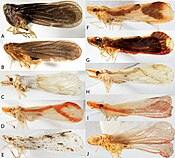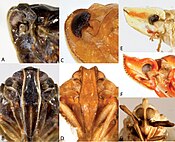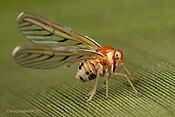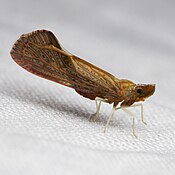
Lethal yellowing (LY) is a phytoplasma disease that attacks many species of palms, including some commercially important species, such as the coconut and date palm. In the Caribbean, it is spread by the planthopper Haplaxius crudus which is native to Florida, parts of the Caribbean, parts of Australia and Central America. The only effective cure is prevention, e.g., planting resistant varieties of coconut palm and preventing a park-like or golf-course-like environment which attracts the planthopper. Some cultivars, such as the Jamaica Tall coconut cultivar, nearly died out because of lethal yellowing. Heavy turf grasses and similar green ground cover attracts the planthopper to lay its eggs there, and the nymphs develop at the roots of these grasses. The planthoppers' eggs and nymphs can pose a great threat to coconut-growing countries' economies, especially ones into which grass seeds for golf courses and lawns are imported from the Americas.

The family Fulgoridae is a large group of hemipteran insects, especially abundant and diverse in the tropics, containing over 125 genera worldwide. They are mostly of moderate to large size, many with a superficial resemblance to Lepidoptera due to their brilliant and varied coloration. Various genera and species are sometimes referred to as lanternflies or lanthorn flies, though they do not emit light.

A planthopper is any insect in the infraorder Fulgoromorpha, in the suborder Auchenorrhyncha, a group exceeding 12,500 described species worldwide. The name comes from their remarkable resemblance to leaves and other plants of their environment and that they often "hop" for quick transportation in a similar way to that of grasshoppers. However, planthoppers generally walk very slowly. Distributed worldwide, all members of this group are plant-feeders, though few are considered pests. The infraorder contains 2 superfamily, Fulgoroidea and Delphacoidea. Fulgoroids are most reliably distinguished from the other Auchenorrhyncha by two features; the bifurcate (Y-shaped) anal vein in the forewing, and the thickened, three-segmented antennae, with a generally round or egg-shaped second segment (pedicel) that bears a fine filamentous arista.

The Cixiidae are a family of fulgoroid insects, one of many families commonly known as planthoppers, distributed worldwide and comprising more than 2,000 species from over 150 genera.

Dictyopharidae is a family of planthoppers, related to the Fulgoridae. The family comprises nearly 760 species in more than 150 genera which are grouped into two subfamilies, Dictyopharinae and Orgeriinae.

Issidae is a family of planthoppers described by Spinola in 1839, belonging to the order Hemiptera, suborder Auchenorrhyncha superfamily Fulgoroidea.

Nogodinidae is a family of planthoppers. They have membranous wings with delicate venation and can be confused with members of other Fulgoroid families such as the Issidae and Tropiduchidae. Some authors treat it as a subfamily of the Issidae.

Cixiinae is a planthopper subfamily in the family Cixiidae. It is one of three such subfamilies, the other two being the Bothriocerinae and the Borystheninae. While a few species had been tested in a larger study of the Fulgoroidea, neither the Cixiinae nor its tribes were analysed cladistically until 2002. Resolution of tribal relationships is incomplete and additional testing of the tribes with samples larger than one per tribe is needed.
Haplaxius crudus is a planthopper species in the genus Haplaxius.

Lophopidae is a family of fulgoroid plant-hoppers with most species found in tropical South America and Asia.

Kinnaridae is a family of fulgoroid planthoppers. This is a small family with a little more than 20 genera and about a 100 species. The family was erected by Muir in 1925 and most members are found in the Oriental and Neotropical regions and only a few in the Nearctic and Palaearctic regions.

Delphacinae is a subfamily of delphacid planthoppers in the family Delphacidae. There are at least 1,700 described species in Delphacinae.

Melanoliarus is a genus of cixiid planthoppers in the family Cixiidae. There are at about 50 described species in Melanoliarus, which are common and widespread in the Nearctic and Neotropics.

Achilidae is a family of planthoppers, sometimes called "achilids" in the order Hemiptera. There are at least 520 described species in Achilidae.

Otiocerinae is a subfamily of derbid planthoppers in the family Derbidae. There are about 7 genera and more than 90 described species in Otiocerinae.

Cenchreini is a tribe of derbid planthoppers in the family Derbidae. There are at least 30 genera in Cenchreini.

Derbinae is a subfamily of derbid planthoppers in the family Derbidae.

Dictyopharinae is a subfamily of dictyopharid planthoppers in the family Dictyopharidae. There more than 100 genera and 500 described species in Dictyopharinae.
The Gengidae are a family of Fulgoromorpha (planthoppers), with species found in South Africa.

The Achilixiidae are a family of Fulgoromorpha (planthoppers); species may be found in the neotropical and Asian regions. They are closely related to Achilidae and are sometimes included under Achilidae as a subfamily. Like Achilidae, species generally feed on several species of plant though the nymph stage has been found to feed on fungus. Like other planthoppers, the immature stage is covered in a wax which may help protect it from predators. Achilixiidae are small or medium sized for planthoppers and are greatly compressed, not depressed like the Achilidae.

























